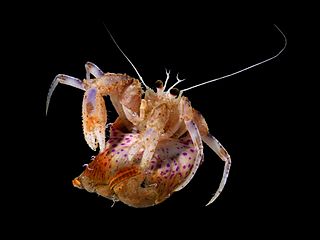
Libinia emarginata, the portly spider crab, common spider crab or nine-spined spider crab, is a species of stenohaline crab that lives on the Atlantic coast of North America.

Cancer pagurus, commonly known as the edible crab or brown crab, is a species of crab found in the North Sea, North Atlantic Ocean, and perhaps the Mediterranean Sea. It is a robust crab of a reddish-brown colour, having an oval carapace with a characteristic "pie crust" edge and black tips to the claws. A mature adult may have a carapace width up to 25 centimetres and weigh up to 3 kilograms. C. pagurus is a nocturnal predator, targeting a range of molluscs and crustaceans. It is the subject of the largest crab fishery in Western Europe, centred on the coasts of the British Isles, with more than 60,000 tonnes caught annually.

Carcinus maenas is a common littoral crab. It is known by different names around the world. In the British Isles, it is generally referred to as the shore crab, or green shore crab. In North America and South Africa, it bears the name European green crab.

The great spider crab, Hyas araneus, is a species of crab found in northeast Atlantic waters and the North Sea, usually below the tidal zone.

The Scotch bonnet is a medium-sized to large species of sea snail, a marine gastropod mollusk in the subfamily Cassinae, the helmet shells and bonnet shells. The common name "Scotch bonnet" alludes to the general outline and color pattern of the shell, which vaguely resemble a tam o' shanter, a traditional Scottish bonnet or cap. The shell is egg-shaped and fairly large, 2 to 4 inches in maximum dimension, with a regular pattern of yellow, orange or brown squarish spots. The surface sculpture of the shell is highly variable: the surface can be smooth and polished, have grooves, be granulated, or even be nodulose on the shoulder of the whorls.

Leptuca pugilator, the sand fiddler crab, Atlantic sand fiddler crab, or Calico fiddler, is a species of fiddler crab that is found from Massachusetts to the Gulf of Mexico. It lives in burrows in coastal and estuarine mud-flats, and can be extremely abundant. It can be differentiated from the morphologically similar Minuca pugnax and Minuca minax by the smoothness of the inside of its claws. One claw is larger than the other, and can be much larger than the crab's body, at up to 41 mm (1.6 in) long.

The Majoidea are a superfamily of crabs which includes the various spider crabs.

Crepidula fornicata is a species of medium-sized sea snail, a marine gastropod mollusc in the family Calyptraeidae, the slipper snails and cup and saucer snails. It has many common names, including common slipper shell, common Atlantic slippersnail, boat shell, quarterdeck shell, fornicating slipper snail, Atlantic slipper limpet and it is in Britain as the "common slipper limpet".

Pagurus longicarpus, the long-wristed hermit crab, is a common hermit crab found along the Atlantic and Gulf coasts of the United States and the Atlantic coast of Canada.

Hydractinia echinata is a colonial marine hydroid which is often found growing on dead, hermit-crabbed shells of marine gastropod species. This hydroid species is also commonly known as snail fur, a name which refers to the furry appearance that the hydroids give to a shell.

Inachus dorsettensis, commonly known as the scorpion spider crab, is a species of crab generally found on loose substrates from 6 metres (20 ft) depth down to about 100 m (330 ft).

Goneplax rhomboides is a species of crab. It is known by the common name angular crab because of its angular carapace. Although it is also called the square crab, its shell is in fact more trapezoidal than square. This species is also known as the mud-runner because they are able to run away quickly when threatened.

Diogenes pugilator is a species of hermit crab, sometimes called the small hermit crab or south-claw hermit crab. It is found from the coast of Angola to as far north as the North Sea, and eastwards through the Mediterranean Sea, Black Sea and Red Sea. Populations of D. pugilator may be kept in check by the predatory crab Liocarcinus depurator.

Hyas is a genus of oregoniid crabs comprising five extant species:

Crepidula convexa is a species of sea snail, a marine gastropod mollusk in the family Calyptraeidae, the slipper snails or slipper limpets, cup-and-saucer snails, and Chinese hat snails. The maximum recorded shell length is 20 mm.

Pagurus prideaux is a species of hermit crab in the family Paguridae. It is found in shallow waters off the northwest coast of Europe and usually lives symbiotically with the sea anemone Adamsia palliata.

Around 65 species of crab occur in the waters of the British Isles. All are marine, with the exception of the introduced Chinese mitten crab, Eriocheir sinensis, which occurs in fresh and brackish water. They range in size from the deep-water species Paromola cuvieri, which can reach a claw span of 1.2 metres, to the pea crab, which is only 4 mm (0.16 in) wide and lives inside mussel shells.

Polybius henslowii is a species of crab, the only species in the genus Polybius. It is a capable swimmer and feeds in open water in the north-east Atlantic Ocean and western Mediterranean Sea.
Pagurus forbesii is a species of hermit crab in the family Paguridae. It is found in the northeastern Atlantic Ocean and the Mediterranean Sea.


















